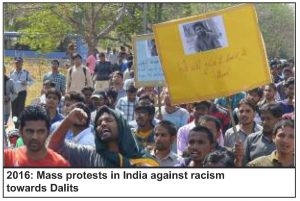
India became a battleground for rising capitalist European powers competing for trade and natural resources in the 15th century. Europeans found feudal kings ruling locally while the Moghul Empire slowly disintegrated. By the mid-18th century, British capitalists consolidated their rule.
For the masses, this meant unprecedented horrific devastation. British colonial administrators required the cultivation of crops to support British industry instead of food for local consumption, creating famine. Mass peasant rebellions erupted, expanding to open armed conflict and culminating in the “Sepoy Rebellion” of 1857.
The British crushed the Sepoy Rebellion. But they realized they needed to divide the Indian masses to prevent future rebellions, much as they created racism in their American colonies in the 17th century. This time they seized on religious divisions. They adopted a theory proposed by James Mill, who had never visited India, in his book The History of British India (1818).
British administrators provoked conflict among the peasants and city dwellers based on religion. They paid Hindu priests to throw pork in front of Muslim mosques. They bribed Muslim mullahs to throw beef in front of Hindu temples. They also enforced strict rules of segregation based on religion and the centuries-old Hindu caste system to further divide the oppressed peasants.
The British rulers created a hierarchy of over 3000 castes and 25000 sub-castes. They classified some rebellious peasants as the ‘untouchable’ caste, many of whom are today’s Dalits. This helped British imperialists reap super-profits from the huge wage differences between workers in Britain and in India.
An emerging Indian capitalist class started to monopolize steel, coal, textile industries. But its growth was restricted by British rule. So it formed the nationalist Indian National Congress (Congress Party) in 1885 to mobilize Indian industrial workers and peasants to support Indian capitalists against the British.
The emergence of the industrial working class also brought unity among the workers at the point of production in factories. Regardless of their religion or caste, the workers faced the same capitalist enemy. Against all the attempts to divide the workers, a revolutionary working class was emerging.
The Russian Revolution of 1917 spurred the formation of the Communist Party of India (CPI). Its members came from both Hindu and Muslim backgrounds. The CPI built a mass base in several regions and led millions in political strikes against British imperialism.
When Gandhi became the leader of the Congress Party in 1921, he mobilized for non-violence in opposition to the militant working class rising against its class enemy. He did not advocate ending the caste system.
Like the British, Gandhi promoted the myth of a glorious Hindu past. He wanted an independent India based on Hindu culture, while cynically trying to unite Hindu and Muslim workers against the British. In South Africa, he had pushed racism against black workers in an effort to get the racist rulers to accept Indians as “white.”
The CPI rightly called Gandhi a junior partner of Indian capitalists. However, the old international communist movement mistakenly regarded nationalism as a progressive force against colonialism. When World War II began, the CPI followed the class-collaborationist line of the Communist International and ended its armed struggle against British rule. Today we understand that communists must mobilize the masses for communism and nothing else.
After World War II, the bloody partition of Hindu India from Muslim Pakistan intensified the religious hostilities created by capitalism. The Congress Party rulers of India, freed from British domination, unleashed terror and grinding poverty on the working class.
Indian politicians intensified divisions based on the caste system in the service of a rising Indian capitalist class. This system has been racialized, with the glorification of lighter skin and physical attacks on Africans and others with darker skins. Modi’s ultra-nationalist Hindu BJP, building fascism to boost their global ambitions, has picked up where Congress left off.
There is a growing mass movement fighting anti-Dalit racism in India today. The International Communist Workers’ Party is involved in that movement. We explain patiently that only communism can uproot the material basis of racism and finally end it.


